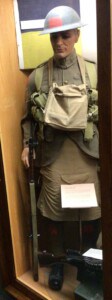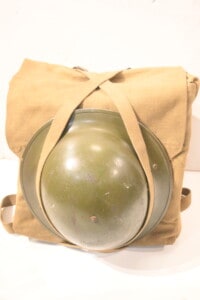Service Dress 1916: steel helmet with “Red Patch” of 1st Division and above a blue triangle of 3rd Brigade ; wool tunic – Davidson Kilt – khaki kilt apron; khaki wool socks with tops – red garter knots – ankle boots; respirator & bug – webbing – 10 pouches (each contains 2 magazines for rounds); Back pack with ground sheet – water bottle & case; Entrenching tool with case – bayonet Frog with dummy bayonet; 48th H of C brass buttons (5 large, 6 small); 48th Highlander 15th Battalion collar “dogs” (2); shoulder titles 48th H of C (2) , red Division patch with 3rd Brigade triangle (2); Sgt’s stripes khaki (2); back pack with steel helmet held on by straps (on floor beside mannequin)
Note: the Lee Enfield rifle(Accessioned separately) has wire cutter mounted on bayonet slot.
Sergeant, Marching Order
A light cotton version of this uniform was first issued to troops departing for South Africa in 1899 but not mass issued till the spring of 1914 with war eminent in Europe. Its first version worn included a Khaki Service (Pith type) Helmet, Khaki tunic, 1908 pattern webbing accoutrement, Khaki kilt apron, Khaki spats and oxford shoes.
In the European trenches this dress found unsuitable for the cold, wet and muddy conditions. Ankle Boots and Putties replaced oxfords and gaiters. Pith helmets replaced prior to leaving Canada with Blue Glengarry, which were replaced by Khaki Tam O’Shanters and then metal Helmets. Gas masks were added to the equipment along with entrenching tools.
Service dress remained the 48th field uniform until 1939. The Sergeant depicted here in Service dress in its final form. The rifle carried by the Sergeant has an attachment to cut wire.
In 1915/1916 the Oliver equipment and Canadian Service dress issued in Canada in 1914 were replaced with British web and dress. In the trenches the Highlanders replaced their glengarry (a blue Scottish cap with red, white and black checkered sides) with a Tam O’Shanter. The khaki Tam O’Shanter, which became known as a balmoral in Canada, reduced sniping casualties. Trenches demanded entrenching tools, steel helmets to protect against shrapnel and gas masks after the disastrous attacks of 1915.
The British pattern tunic for the men was of coarse wool, cut away to accommodate the kilt. A ‘stand up and fall collar’ resembled that of a dress shirt, on the tips of which were worn a miniature version of the cap badge. Down the front were five brass buttons of regimental pattern and on the epaulettes brass regimental numerals. The jacket had pleated pockets on both breasts with a second plain set below the waist, all with flaps secured by brass buttons.
The Highlander in the trenches retained his kilt, which was covered by a khaki apron with a pouch sewn in its centre replacing the sporran. Wearing issued trousers or shorts was an option but most Highlanders elected to wear the kilt throughout the war. Khaki hose replaced the diamond-pattern hose although the garter remained. Wrapped around the hose instead of spats were putties (long strips of cloth intended to cover the trouser legs). The waterlogged trenches forced a change from shoes to hobnailed ankle boots. The new webbing, by holding everything together for the first time, streamlined what the infantry soldier carried. Made of a woven material it conformed to the body better than leather and was less likely to chafe. The layout remained traditional: magazine pouches and bayonet frog on the belt, haversack and water bottle suspended below, and a large pack, suspended by cross straps connected to the belt front and back. For the first time, division and brigade patches were added to the tunic, to display the identity of the senior formations. The “red patch” was worn proudly by members of the 1st Canadian Division. Above it, the 48th wore the blue triangle of the 3rd Infantry Brigade.


